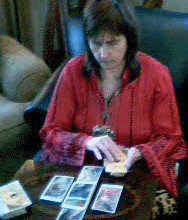~ History of the Tarot ~
Playing cards first appeared in Europe around the
end of the 14th century, with suits quite similar to the tarot suits of Swords, Cups, Staves, and Pentacles. The first
known tarot cards were created between 1430 and 1450 in Milan, Ferrara and Bologna in northern Italy, when additional
allegorical illustrations were added to the typical four-suit pack. These new decks were initially called triumph
cards, and the additional cards known simply as trionfi, "trumps" in English.
Though originally intended for the playing of games, divination using playing cards is in evidence
as early as 1540 in a book entitled The Oracles of Francesco Marcolino da Forli which allows a simple method
of divination, though the cards are used only to select a random oracle and have no meaning in themselves. Writings
from 1735 and 1750 document rudimentary divinatory meanings for the cards of the tarot as well as a system for laying
out the cards.
Tarot cards would eventually become associated with mysticism and magic but they were not widely
adopted by seers, mystics, and occultists until the 18th and 19th centuries. In 1781 a Swiss clergyman Antoine Court
de Gébelin published a study that included the topic of the survival of religious symbolisms in the modern world.
Gébelin asserted that the name "tarot" came from the Egyptian words tar, "royal", and ro, "road", and that the Tarot
represented a "royal road" to knowledge. He proposed that symbolism of the Tarot de Marseille represented the
mysteries of Isis and Thoth. De Gébelin also asserted that the Romanies, who were among the first to use cards for
divination, were descendants of the ancient Egyptians and had introduced the cards to Europe, though no Egyptian writings
discovered so far validate this assertion. Regardless, the identification of the tarot cards with the Egyptian Book
of Thoth was firmly established in occult practice and continues to the present.
|
|
|
French occultist Jean-Baptiste Alliette, in the 1780's, was the first to issue
a tarot deck specifically designed for divination rather than game playing. In keeping with the belief that tarot
cards are derived from the Book of Thoth, his tarot contained themes related to ancient Egypt. In the nineteenth
century occultist Eliphas Levi attributed the origins of the Tarot to Israel, when he asserted the existence of a
correlation between the Kabbalah and the Tarot. In 1910 Arthur Waite and artist Pamela Coleman Smith produced a Tarot
deck that was a culmination of the wisdom of many societies and became an unofficial standard, the influence of which
can be seen in very many modern decks.
|
































